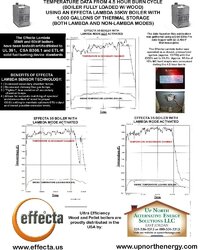By George, I think I've done it !
!
I've been working on getting the effecta lambda boilers tested/certified/listed to UL and CSA standards and the testing is finally completed. We should have these boilers officially listed within the next month or so.
Now for the really good stuff. I've attached a document which contains data logging results of my effect lambda boiler operating in both lambda and non-lambda modes.
As you can see from the detailed charts/data, the effecta lambda control system gets the boilers efficiency and operating ease to the next level. The biggest difference I see is the lowering of the exhaust gases by almost 100 F when the lambda sensor is used to automatically/continuously control the amount of oxygen introduced into the primary and secondary burn chambers throughout the entire burn (approx 4.5 hours). This lowering of exhaust gas temperatures correlates directly to an increase in the secondary burn temperatures and a more consistent burn - less ups and downs in addition to more useful BTU's into the WATER BATTERY ! Simply put, more BTU's per pound of wood.
! Simply put, more BTU's per pound of wood.
I am looking forward to the feedback I get on this detailed data. As far as I know, this is the first time that both secondary temps and flue temps have been measured for both lambda and non-lambda controlled boilers.
Happily and easily heating my home with an effecta lambda 35 in northern Michigan !
!
EBU
 !
!I've been working on getting the effecta lambda boilers tested/certified/listed to UL and CSA standards and the testing is finally completed. We should have these boilers officially listed within the next month or so.
Now for the really good stuff. I've attached a document which contains data logging results of my effect lambda boiler operating in both lambda and non-lambda modes.
As you can see from the detailed charts/data, the effecta lambda control system gets the boilers efficiency and operating ease to the next level. The biggest difference I see is the lowering of the exhaust gases by almost 100 F when the lambda sensor is used to automatically/continuously control the amount of oxygen introduced into the primary and secondary burn chambers throughout the entire burn (approx 4.5 hours). This lowering of exhaust gas temperatures correlates directly to an increase in the secondary burn temperatures and a more consistent burn - less ups and downs in addition to more useful BTU's into the WATER BATTERY
 ! Simply put, more BTU's per pound of wood.
! Simply put, more BTU's per pound of wood.I am looking forward to the feedback I get on this detailed data. As far as I know, this is the first time that both secondary temps and flue temps have been measured for both lambda and non-lambda controlled boilers.
Happily and easily heating my home with an effecta lambda 35 in northern Michigan
 !
!EBU


